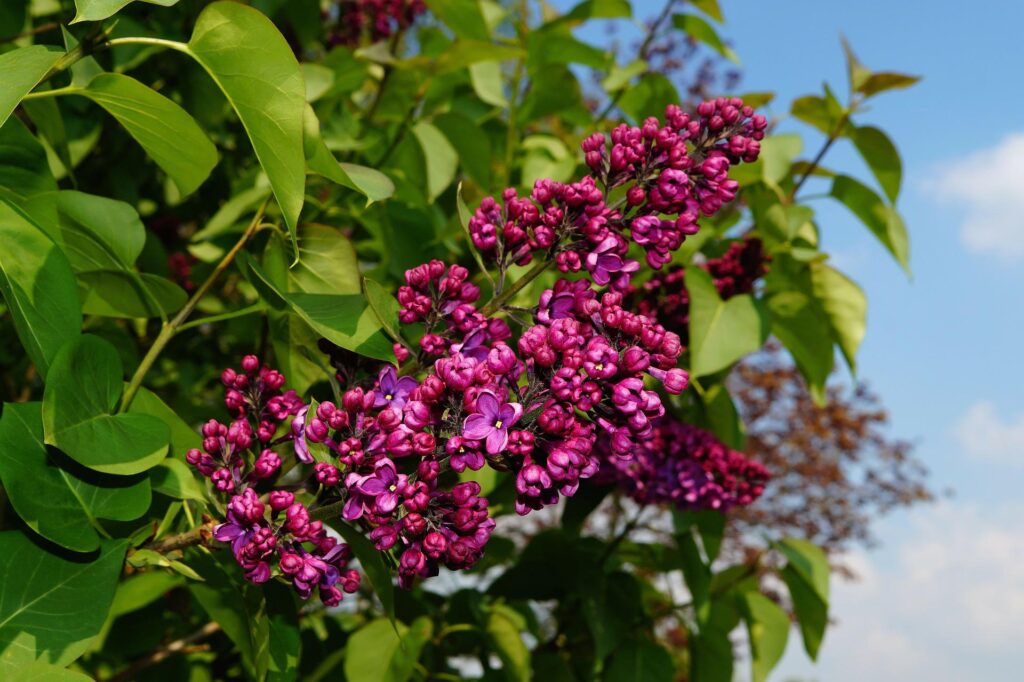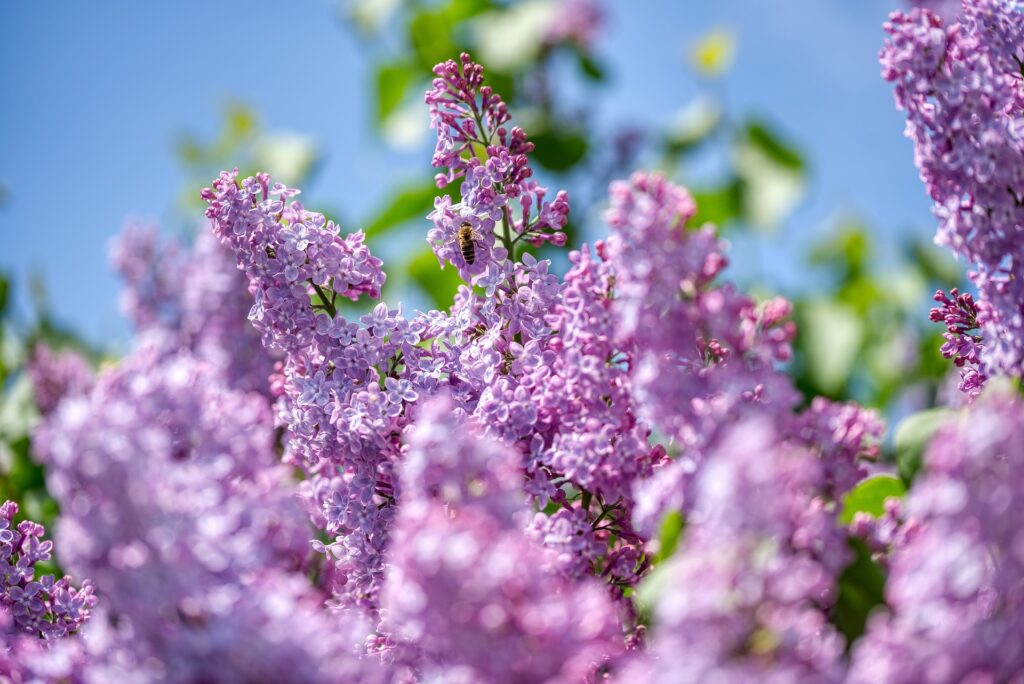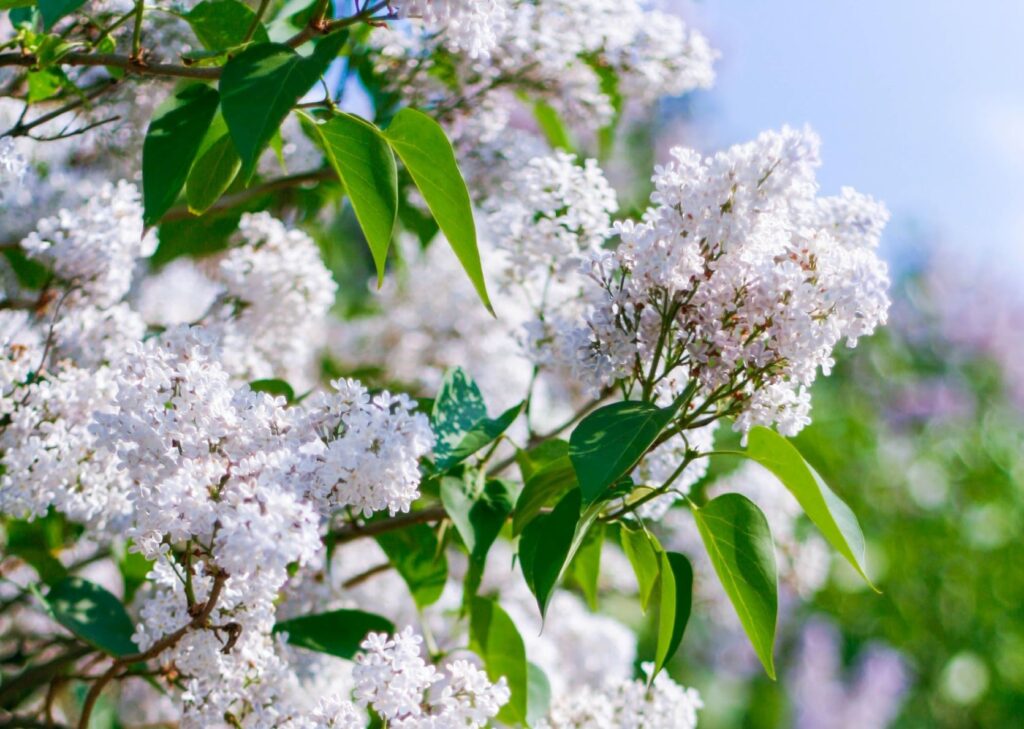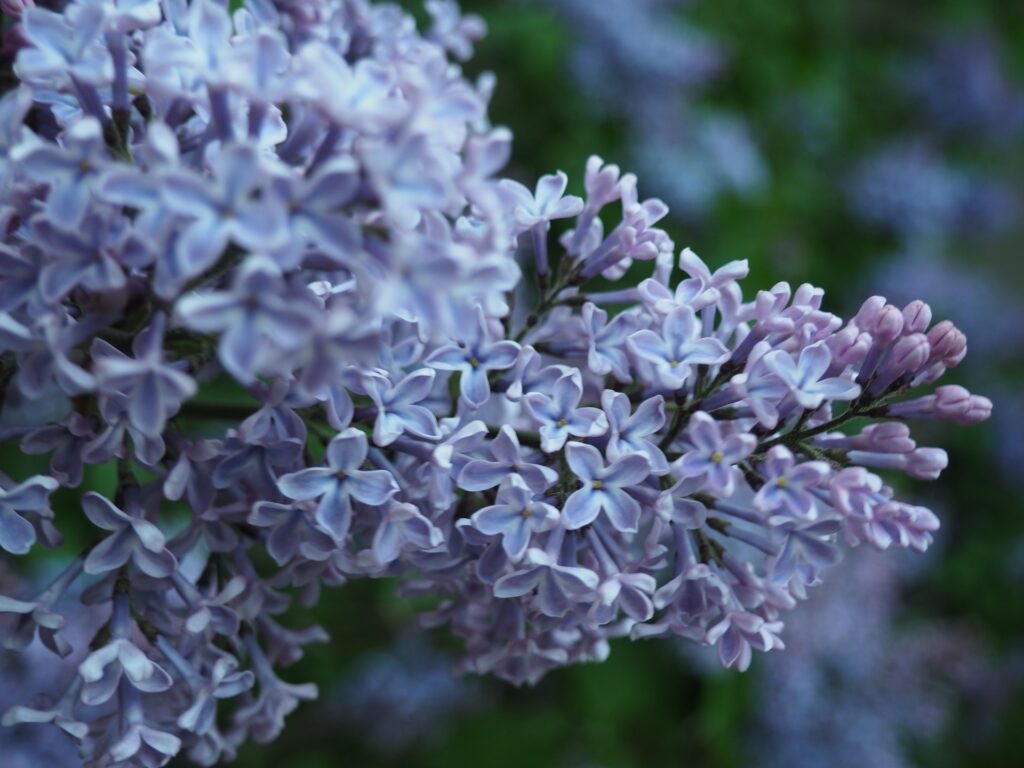Lovely Lilac & Its Companions

Lilac is one of the spring blooming bushes that add beautiful colours and sweet fragrance to your garden.
They are part of the olive family, along with other ornamental plants as ash trees, forsythia bushes, and privet hedges.
A lilac in full bloom is a breathtaking sight. Easy to grow, deer resistant and low maintenance, these hardy shrubs have been tailored to meet the needs of all gardens.
Lilacs can be grown as focal points in the landscape or planted in rows along property borders to create deciduous hedges.

BLOOMING TIME OF LILACS
Did you know that different lilacs varieties bloom during different times? So, you can mix them to extend their blooming season in your garden.
Depending on where you live, and the lilac varieties you choose, lilacs can provide colour and fragrance from April through June. By selecting carefully, it is possible to have two months of spring blooms, particularly if the weather is cool. A warm spring will, however, bring flowers out early, shortening the blooming season by a few weeks.
EARLY BLOOMING LILACS
For the earliest blooms, choose Syringa x hyacinthiflora (Hyacinth Syringa) or Syringa oblata ‘Betsy Ross’: they burst into bloom in mid-spring, about 7-10 days earlier than Syringa vulgaris (Common Lilac).
Common Lilac (Syringa vulgaris) is the longest blooming species, lasting for a month depending on cultivar and region. Typically blooming in late spring, it offers the largest flowers with the best fragrance.
MID-SEASON BLOMING LILACS
Mid-season blooming lilacs are Syringa meyeri ‘Palibin’, Syringa pubescens subsp. patula ‘Miss Kim’, Syringa x chinensis ‘Lilac Sunday’ (Chinese Lilac), Syringa x laciniata (Cutleaf Lilac), Syringa x persica (Persian Lilac).
LATE BLOOMING LILACS
Extend the lilac season to summer with species such as Syringa microphylla (Littleleaf Lilac), Syringa reticulata (Japanese tree lilac), or Syringa x prestoniae (Preston Lilac).
If your space is limited and you cannot enjoy several lilac varieties, you may want to choose a reblooming lilac. These lilac shrubs do not only bloom in spring but repeat bloom in summer and fall, bringing their wonderful colour and scent in the garden.

PROPAGATION
Most lilacs are clump-forming plants that spread via shoots extending from the trunk. And these shoots can be used for propagation. The best time to propagate is in the late spring to early summer to give the shoot enough time to become established before cold weather sets in.
To propagate, simply dig down around one of the shoots and cut it from the main plant, keeping the roots intact. Then, replant the shoot in rich soil wherever you wish, and keep the soil lightly moist (but not soggy) at all times until it’s established.
PRUNING & DEADHEADING
Pruning lilacs is generally an annual task and should be done after they finish blooming (unlike most of the other bushes and trees). Pruning is critical for lilacs, both to promote flowering and to ensure air circulation to prevent powdery mildew and other problems.
Deadheading, or removing the spent lilac blooms, isn’t necessary.
LIGHT & SOIL
Lilacs love to be in full sun (minimum 6 hours of direct sunlight). A lack of sunlight is often the reason for poor flowering on a lilac. Lightly moist soil (neutral or alkaline) also encourages a stronger bloom. Mulch around the shrub can help to retain soil moisture and suppress weeds that might compete with the lilac.
NOT ENOUGH FLOWERS?
A lilac that isn’t flowering as much as it used to might need a rejuvenation pruning. To do so, remove a third of the oldest branches right after the bloom period is over. In the next growing season, remove half of the remaining old branches after flowering. And in the next year, remove the rest of the remaining old branches. New branches that flower more vigorously will replace them in a few years.

COMPANION PLANTS
While extraordinary good-looking on their own during their blooming season, lilacs flowers are very short-lived. Surrounding your lilacs with a succession of flowers and foliage plants will reinforce the beauty of their blooms and extend the season of interest of your garden.
Here is the list of favourite companion plants for your lilacs.
Conifers add year-round beauty and structure to your garden and will do well next to your lilacs. Choose between pines (Pinus), Spruces (Picea), Firs (Abies), Cedars (Cedrus), False Cypresses (Chamaecyparis), and many others.
Flowering Crabapples (Malus) have two seasons of interest: blooming 1-2 weeks before the lilacs in spring and producing colorful fruit from summer into the later fall. The fruits are not for people to enjoy, but great for birds, insects and small animals.
Flowering Dogwood (Cornus) are wonderful companions for early-blooming lilacs. They are famous for their foliage which turns to gorgeous shades of gold, red or purple in fall. They will also produce red berries later in the season that attract songbirds.
Flowering Cherries (Prunus) are another option to decorate your garden with spring flowers and beautiful foliage. Most of them are at their peak when the lilacs are still in bloom and together they create a spectacular harmony of colours.
Magnolias are early flowering trees, blooming at similar time as Syringa vulgaris, the common lilac.
Weigela features vibrant green foliage and petite flowers, which can attract hummingbirds and butterflies to your garden when they bloom in early summer.
Clematis will extend the season of interest for your lilacs when planted next to them. The great advantage is that clematis blooms after a spring-flowering lilac is already done. Clematis viticella is the most popular choice to grow through the branches of the lilac shrubs.
Passion flowers (Passiflora) are easy to grow with bold, intricate flowers, and some species even produce delicious passion fruit. Passion vines are trouble free climbers that cling to the branches of lilacs. Check out the hardiness zone before you decide on growing passion flowers in your garden. The most hardy variety is Passiflora incarnata (Wild Passion Flower).
Peonies are wonderful companions to lilacs with variety of colours and their beautiful foliage. Planted next to lilacs they will hide the long bare branches of lilacs.
Hostas will complement lilacs nicely with their large, green leaves, creating a striking green blanket for your lilac bushes. Hostas are available in a wide choice of colors and shapes, so try to match with the colours of your lilacs flowers.
Hemerocallis (Daylilies) are colourful perennials that will look wonderful at the base of lilacs. Daylilies are low maintenance, delightfully fragrant, attract pollinators. They are available in so many colours and will bloom for a long time. Note that deer might love daylilies too.
Spring-flowering bulbs make a natural choice as companion plants for lilac bushes because they bloom at the same time. Bulb plants like daffodils, tulips, grape hyacinth multiply and naturalize. Plant enough of them and you’ll never weed in the area again.
